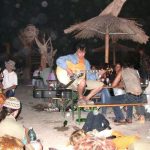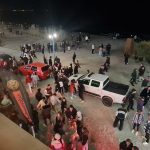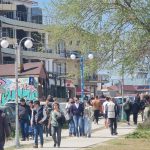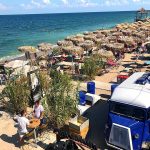Transport de seara de la Constanta la Vama Veche in fiecare zi la ora 21:00
8 iunie 2023 – 24 septembrie 2023
PRET: 20 Euro
La cerere (optional, plata suplimentara) dimineata se poate organiza si transport retur, Vama Veche la Constanta de la ora 5:30
Ora limita: locurile nu se mai confirma automat cu 12 ore inainte de ora de incepere.
Punctul si ora de intâlnire: ora 21:00 la Gara, Constanta 900178, România. Ne intâlnim cu toti calatorii la un punct de intâlnire, in fata garii (la vaporas), dar din cauza lucrarilor de constructie este mai bine sa scrieti un mesaj pe what’s up la: +40740630207.
Puncte finale: Vama Veche 907163, Romania
Durata totala: 50 – 120 minute
Veti vedea pe cineva cu un semn rosu cu inscriptia „ALMA” si va aparea o poza cu o inima rosie. Vom merge direct spre Vama Veche, dar este posibil sa facem si un drum prin unele statiuni, in functie de evenimentele de pe drum si de cât de aglomerat este traficul.
Satul Vama Veche a fost fondat in anul 1811. In timpul dictaturii comuniste, satul nu era vizitat de turisti. Fenomenul „Vama Veche” (muzica buna, spirit boem, atmosfera intelectuala) a aparut in anii 70 când Universitatea Babes-Bolyai din Cluj-Napoca trimitea profesori sa se relaxeze aici in fiecare vara. Au ajuns in grupuri organizate cu autobuzul si au ramas in casele localnicilor. In acea vreme in sat locuiau aproximativ 70 de familii. Universitarii au mâncat zilnic in cantina amenajata de universitate (acum o cladire parasita), unde erau pregatite preparate de bucatari veniti si din Cluj. Universitatea din Cluj a mai construit doua dusuri cu rezervoare de apa foarte mari montate pe stâlpi. Un dus a fost instalat in curtea cantinei, celalalt era in drum spre plaja si fosta cazemata. Seara s-au adunat pe plaja, unde s-au facut focuri de tabara, s-au purtat discutii si s-au cântat cântece românesti, franceze si engleze la chitara. Grupurile se schimbau la fiecare zece zile. S-au realizat si filmari in Vama Veche pentru diverse filme românesti. Aceasta deschidere, adusa de intelectualii clujeni si de actorii români, a creat atmosfera intelectual-boema a locului in aceasta perioada si a oferit localnicilor posibilitatea de a intra in contact cu evenimente si oameni de inalta calitate.
Elena Ceausescu, sotia fostului dictator, care se deplasa in Bulgaria cu un convoi oficial, in timpul unei vizite din vara anului 1988, a fost profund tulburata de aspectul satului pescaresc (un loc cu stuf si balti, cu putini locuitori, majoritatea saraci si a decis sa demoleze casele. Actiunea a inceput in 1989 când au disparut câteva case mai instarite, scoala si biserica. Intreg satul urma sa fie darâmat. Localnicii au ramas in casele lor in timpul demolarii pentru a le salva si au fortat autoritatile sa-i lase in pace. Unii dintre ei au suferit atacuri de cord in propriile case când buldozerul de demolare a venit in apropierea lor. Din fericire, Revolutia Româna din 1989 a reusit sa salveze satul de la distrugere. Imediat dupa revolutie, aici au venit niste familii intreprinzatoare din Ploiesti si Bucuresti si au infiintat primele mici afaceri locale, restaurante sau baruri.
Pâna la sfârsitul anilor 1990, Vama Veche era cunoscuta ca un sat de pescari a carui plaja atragea putini turisti si era in mare parte populara printre nudisti. Totusi, in ultimii 10 ani, locul a cunoscut un aflux puternic de turisti, care si-a schimbat complet vechiul aspect odata cu aparitia de noi cladiri si spatii comerciale.
Ghidajul pana la destinatie poate fi poate fi in engleza, germana, spaniola, bulgara sau in alte limbi.
Nu este recomandat pentru:
– calatori cu probleme de spate
– femei insarcinate
– pentru calatorii cu probleme cardiace sau alte afectiuni medicale grave
Este o statiune de petrecere in care oamenii danseaza toata noaptea si dorm pe plaja.
Numar de telefon: +40 740 630 207
Evening transport from Constanta to Vama Veche every day at 21:00
June 8, 2023 – September 24, 2023
PRICE: 20 Euro
On request (optional, additional payment) in the morning, return transport can be organized, Vama Veche to Constanta starting with 5:30
Time limit: places are no longer automatically confirmed 12 hours before the start time.
Meeting point and time: 21:00 at the Train Station, Constanta 900178, Romania. We meet all travelers at a meeting point, in front of the station (at the ferry), but because of the construction works it is better to write a message on what’s up to: +40740630207.
Final points: Vama Veche 907163, Romania
Total duration: 50 – 120 minutes
You will see someone with a red “ALMA” sign and a picture of a red heart will appear. We will go directly to Vama Veche, but it is possible to make a detour through some resorts, depending on the events on the road and how crowded the traffic is.
Vama Veche village was founded in 1811. During the communist dictatorship, the village was not visited by tourists. The “Vama Veche” phenomenon (good music, bohemian spirit, intellectual atmosphere) appeared in the 70s when Babes-Bolyai University in Cluj-Napoca sent professors to relax here every summer. They arrived in organized groups by bus and stayed in the houses of the locals. At that time, approximately 70 families lived in the village. The university students ate daily in the canteen set up by the university (now an abandoned building), where dishes were prepared by chefs from Cluj. The University of Cluj also built two showers with very large water tanks mounted on poles. One shower was installed in the courtyard of the canteen, the other was on the way to the beach and the former casemate. In the evening they gathered on the beach, where campfires were made, discussions were held and Romanian, French and English songs were played on the guitar. The groups changed every ten days. Filming was also done in Vama Veche for various Romanian films. This openness, brought by Cluj intellectuals and Romanian actors, created the intellectual-bohemian atmosphere of the place during this period and offered the locals the opportunity to come into contact with high-quality events and people.
Elena Ceausescu, the wife of the former dictator, who was traveling in Bulgaria with an official convoy, during a visit in the summer of 1988, was deeply disturbed by the appearance of the fishing village (a place with reeds and puddles, with few inhabitants, most of them poor and decided to demolish the houses. The action started in 1989 when a few wealthier houses, the school and the church disappeared. The whole village was going to be demolished. The locals stayed in their houses during the demolition to save them and forced the authorities to let them in peace. Some of them suffered heart attacks in their own houses when the demolition bulldozer came near them. Fortunately, the Romanian Revolution of 1989 managed to save the village from destruction. Immediately after the revolution, some enterprising families came here from Ploiesti and Bucharest and established the first small local businesses, restaurants or bars.
Until the end of the 1990s, Vama Veche was known as a fishing village whose beach attracted few tourists and was mostly popular among nudists. However, in the last 10 years, the place experienced a strong influx of tourists, which completely changed its old appearance with the appearance of new buildings and commercial spaces.
The guide to the destination can be in English, German, Spanish, Bulgarian or other languages.
Not recommended for:
– travelers with back problems
– pregnant women
– for travelers with heart problems or other serious medical conditions
It is a party resort where people dance all night and sleep on the beach.
Phone number: +40 740 630 207
Abendtransport nach Vama Veche – Jeden-Abend um 21:00 Uhr
- Juni 2023 – 24. September 2023
PREIS: 20 €uro
Transport von Vama Veche nach Constanta ab 5:30 Uhr kann im Bus bestellt werden.
Annahmeschluss: Stoppen Sie den Kauf 12 Stunden vor der Startzeit.
Um eine vollständige Rückerstattung zu erhalten, können Reisende bis zu 7 Tage vor Beginn des Erlebnisses in der lokalen Zeitzone stornieren. Nach diesem Zeitraum erfolgt keine Rückerstattung mehr.
Zeigen Sie Ihr Ticket dem Reiseleiter oder Fahrer vor, wenn Sie sich treffen, oder senden Sie eine SMS an: +40740630207.
Treffpunkt und Uhrzeit: 21:00 Uhr in Gara, Constanta 900178, Rumänien. Wir treffen alle Reisenden an einem Treffpunkt vor dem Bahnhof, aber aufgrund von Bauarbeiten ist es besser, anzurufen: +40740630207.
Endpunkte: Vama Veche 907163, Rumänien
Gesamtdauer: 50 – 120 Minuten
Sie werden jemanden mit einem roten Schild mit der Aufschrift „ALMA“ sehen und es wird ein Bild mit einem roten Herzen geben. Wir fahren direkt nach Vama Veche, aber es ist auch möglich, eine malerische Fahrt durch einige Urlaubsorte zu unternehmen.
Das Dorf Vama Veche wurde 1811 gegründet. Während der kommunistischen Diktatur wurde das Dorf nicht von Touristen besucht. Das Phänomen „Vama Veche“ (gute Musik, Bohème-Geist, eine gewisse intellektuelle Note) entstand in den 70er Jahren, als die Babes-Bolyai-Universität in Cluj-Napoca jeden Sommer Professoren zum Entspannen hierher schickte. Sie kamen in organisierten Gruppen mit dem Bus an und wohnten in den Häusern der Einheimischen. Zu dieser Zeit lebten etwa 70 Familien im Dorf. Die Universitätsstudenten aßen täglich in der von der Universität eingerichteten Kantine (heute ein verlassenes Gebäude), in der die Gerichte von Köchen zubereitet wurden, die ebenfalls aus Cluj stammten. Die Universität Cluj baute außerdem zwei Duschen mit sehr großen, auf Stangen montierten Wassertanks. Eine Dusche wurde im Innenhof der Kantine installiert, die andere befand sich auf dem Weg zum Strand und der ehemaligen Kasematte. Am Abend versammelten sie sich am Strand, wo Lagerfeuer gemacht, Diskussionen geführt und rumänische, französische und englische Lieder auf der Gitarre gespielt wurden. Die Gruppen wechselten alle zehn Tage. In Vama Veche wurden auch Dreharbeiten für verschiedene rumänische Filme durchgeführt. Diese von den Clujer Intellektuellen und den rumänischen Schauspielern mitgebrachte Offenheit schuf in dieser Zeit die intellektuell-bohemische Atmosphäre des Ortes und bot den Einheimischen die Möglichkeit, mit hochwertigen Veranstaltungen und Menschen in Kontakt zu kommen.
Elena Ceausescu, die Frau des ehemaligen Diktators, der mit einem offiziellen Konvoi nach Bulgarien reiste, war bei einem Besuch im Sommer 1988 zutiefst beunruhigt über das Aussehen des Fischerdorfes (ein Ort mit Schilf und Pfützen, mit wenigen Einwohnern, meist arme Menschen) und beschluss, ihre Häuser abzureißen. Die Aktion begann im Jahr 1989, als einige weitere wohlhabende Häuser, die Schule und die Kirche verschwanden und das gesamte Dorf dem Erdboden gleichgemacht werden sollte. Die Einheimischen blieben während des Abrisses in ihren Häusern, um sie zu retten und die Behörden zu zwingen, sie in Ruhe zu lassen. Einige von ihnen erlitten in ihren eigenen Häusern einen Herzinfarkt, als der Abbruchbulldozer in ihre Nähe kam. Glücklicherweise gelang es der Rumänischen Revolution von 1989, das Dorf vor der Zerstörung zu bewahren. Unmittelbar nach der Revolution kamen einige unternehmungslustige Familien aus Ploiesti und Bukarest hierher und gründeten die ersten kleinen lokalen Unternehmen, Restaurants oder Gaststätten, die sich heute stark weiterentwickelt und verändert haben.
Bis Ende der 1990er Jahre war Vama Veche als Fischerdorf bekannt, dessen Strand bei Touristen wenig bekannt war und vor allem bei Nudisten beliebt war. Allerdings erlebte der Ort in den letzten 10 Jahren einen starken Zustrom von Touristen, der durch die Entstehung neuer Gebäude und Gewerbeflächen sein altes Erscheinungsbild völlig veränderte.
Ich arbeite seit vielen Jahren im Tourismus und bin ein Einheimischer der rumänischen Küste. Ich bin ein Fan von Vama Veche schon lange. Dies ist der einzige Ort für Träumer und Rockmusikfans mit entspannter Atmosphäre.
Der Fahrt zum Zielort kann in Englisch, Deutsch, Spanisch, Bulgarisch oder anderen Sprachen geleitet sein.
Nicht empfohlen für:
– Reisende mit Rückenproblemen
– schwangere Frauen
– für Reisende mit Herzproblemen oder anderen schwerwiegenden Erkrankungen
Es ist ein Partyresort, in dem die Leute die ganze Nacht tanzen und am Strand schlafen.
Telefonnummer: +40 740 630 207











